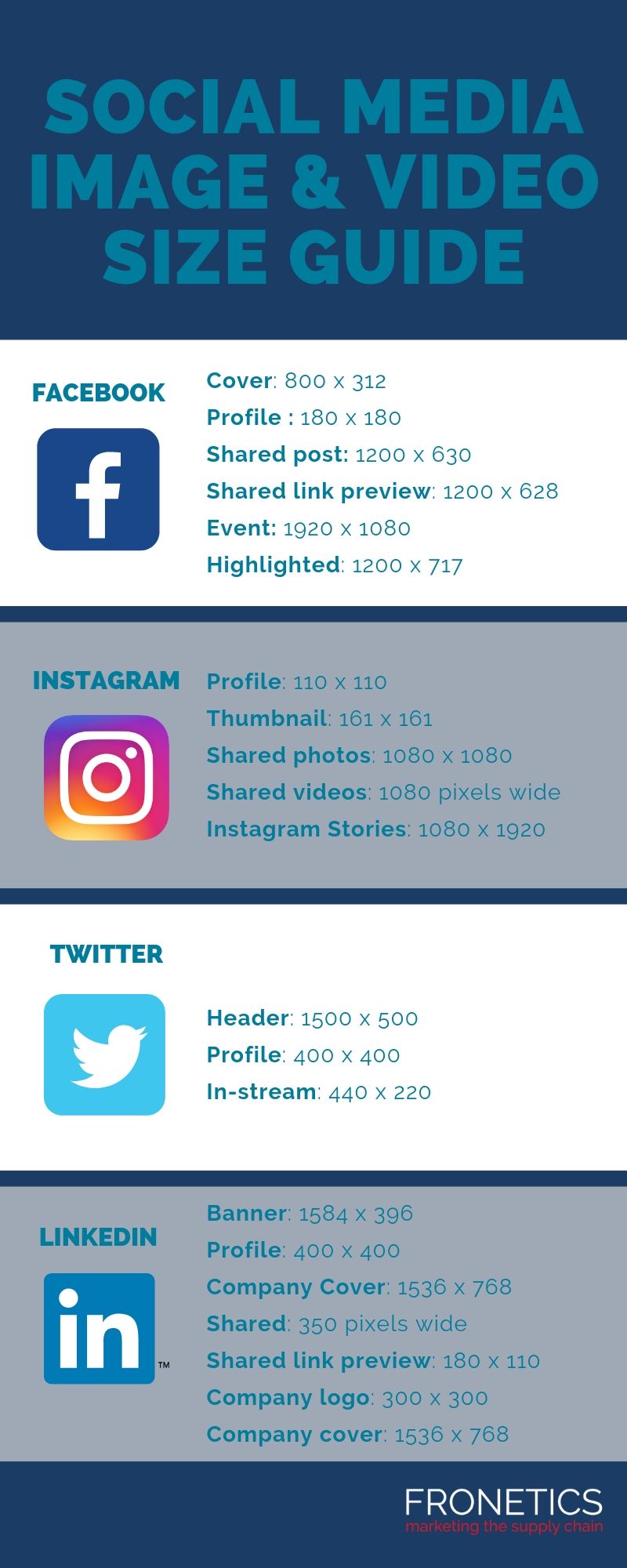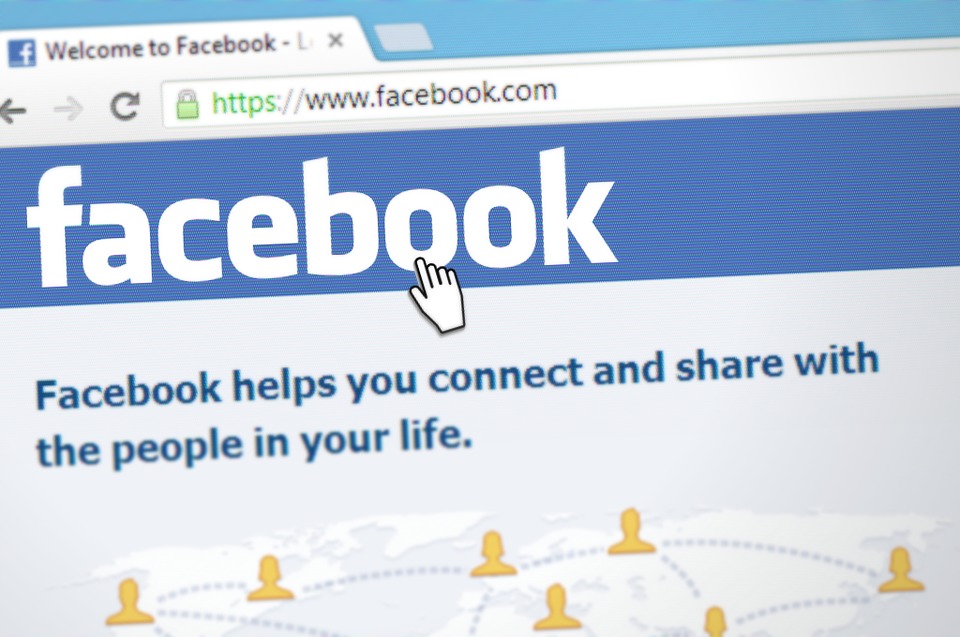
by Fronetics | Oct 4, 2019 | Blog, Current Events, Logistics, Marketing, Social Media, Supply Chain
Also, this month in social media news: a court rules LinkedIn cannot stop third-party scraping public information and Facebook expands “Today In” section.
After a relatively quiet month in the world of social media news, social platforms have been hard at work making changes to provide a better user experience and cut down on spam accounts. This is good news for B2B marketers looking to stand out amongst all the competition.
With the growing influence of social networks, social channels have been challenged with making sure the information shared on their sites is authentic and “real” news. In response, social platforms have been working to sort through fake accounts and streamline ways to detect and remove these accounts, which often result in major losses of followers.
But this decline in user accounts does not mean that social media platforms’ influence is declining. In fact, social media usage is at an all-time high, and networks are pushing out new updates, features and policies to keep users happy.
Here’s your social media news for October 2019.
Facebooks announces new business tool for Messenger
Looking to increase leads and engage with new audiences? Facebook is trying to help. The social network introduced a new package of tools for the 40 million active businesses on Messenger, including booking appointments and lead generation workflows. As the new features were announced, Facebook also reported the Discovery tab will be phased out. According to Facebook, “Businesses engaging with potential leads in their preferred channel are seeing results, and finding it easy to continue the conversation and seamlessly nurture leads in Messenger.”
Twitter tests new ‘topics’ shortcut
Twitter users may soon be able to follow topics in the same way they would follow users. Users can see tweets about topics they choose (like digital marketing, supply chain procurement, or even sports) in the home feed. Individual tweets will be monitored through machine learning and chosen to be included in specific topics.
Though only in the testing phase, the new shortcut would help users discover the exact content they need and want without following a specific account. The Verge reports that Twitter is also working on other ways to improve the user experience, including searchable direct messages, the ability to re-order the photos in a tweet after you have attached them to a new post, and plans to add support for Apple’s Live Photos.
Court rules that LinkedIn cannot stop third-party data scraping of public information
hiQabs has been collecting public user information on LinkedIn to create analytics for employers that accurately identify employee patterns and help with retention efforts. But LinkedIn has tried to block the “data scrapping,” alleging that hiQ was violating the CFAA, as well as the Digital Millennium Copyright Act (DMCA).
Until now, when a San Francisco appeal’s court told LinkedIn to take a step back. The court’s decision means the CFAA doesn’t apply to public information, including information collecting via social media platforms. This decision could have major implications for social platforms looking to protect user privacy. We’ll continue to closely monitor any updates from this case in next month’s social media news.
Facebook expands “Today In” section
“Today In” has been running in six U.S. cities since January 2018, and has over 1.6 million people who have opted to receive regular local updates from Today In within the newsfeed. Facebook just announced they’ll be expanding the news section to 6,000 more U.S. cities and towns, bringing local news to “news deserts,” areas with limited local news available.
“Today In” showcases the biggest news stories and happenings in local regions. With declining engagement rates, Facebook created the separate newsfeed in an effort to boost engagement and discussions around topics that matter to local areas.
Facebook clarifies privacy settings for Groups
Public, closed, or secret? What do these privacy settings mean? Users across Facebook’s platform weren’t sure, so the network has changed the wording describing the privacy settings for groups. To make these settings clearer, groups now have the option of public or private. Facebook writes:
“We’re making this change because we’ve heard from people that they want more clarity about the privacy settings for their groups. Having two privacy settings — public and private — will help make it clearer about who can find the group and see the members and posts that are part of it. We’ve also heard that most people prefer to use the terms “public” and “private” to describe the privacy settings of groups they belong to. “
The changes leave privacy settings more straight-forward. Public groups show anyone who is a member and all the content shared within the group, while private groups will only show members and content to users that join the group.
Related posts:

by Fronetics | Sep 26, 2019 | Blog, Current Events, Marketing, Social Media
Having the right social media image sizes for each platform is a key part of creating visually appealing posts.
Highlights:
- Each social media platform has its own set of image guidelines.
- Choosing the right social media image sizes ensures that your content is as visually appealing as possible.
- We like Canva Pro for quick resizing of images and graphics.
Social media is all about the visual. Whether it’s Instagram, Facebook, Twitter, or LinkedIn, having the right image can make or break the effectiveness of a post. Social media image size might seem like a relatively unimportant facet of choosing an effective image for a post. But you might be surprised to discover how important it can be.
An incorrect social media image size can make your post less visually appealing than it could be, and it can even erode how the number of impressions a post receives. Because each platform has its guidelines for sizes — and because each image type (profile picture, cover photo, etc.) has different size restrictions — determining correct social media image size is no easy task.
The infographic below gives you a complete guide to the various image size requirements on Facebook, Instagram, Twitter, and LinkedIn. Once you know the correct social media image sizes, you can set your photo editing software to the correct dimensions.
Social media image sizes: by the network

(Made with Canva)
Facebook
Facebook is perhaps the crown jewel of social media platforms, boasting 1.5 billion daily active users. While the platform is text-friendly, images are key to creating engaging content on the platform. An important thing to remember when it comes to images on Facebook is that they will display differently on your page’s timeline as compared to a user’s newsfeed. This means that your choice of image dimensions should be based on where you want your viewers to see your image.
Image dimensions:
- Cover image: 800 x 312
- Profile image: 180 x 180 (though it will display as 170 x 170 on desktop, and 32 x 32 as a thumbnail)
- Shared post image: 1200 x 630
- Shared link preview image: 1200 x 628
- Event image: 1920 x 1080
- Highlighted image: 1200 x 717
Instagram
Instagram is all about the visual – which means that it’s crucial that your brand’s presence on the platform is driven by high-quality images. As a rule, the platform scales down photos to 612 x 612, but it’s still recommended that shared images be set to 1080 x 1080 to optimize quality.
Image dimensions:
- Profile image: 110 x 110
- Image thumbnail: 161 x 161
- Shared photos: 1080 x 1080
- Shared videos: 1080 pixels wide
- Instagram Stories: 1080 x 1920 (minimum 600 x 1067); maximum 4 GB
Twitter
Twitter has 313 billion monthly active users and has recently updated its image guidelines.
Image dimensions:
- Header image: 1500 x 500; maximum 5 MB
- Profile image: 400 x 400; maximum 2 MB
- In-stream image: 440 x 220
LinkedIn
While the network may not be thought of as a highly visual platform, images on LinkedIn make a big difference in terms of post engagement. With 467 million registered users, it’s the world’s largest professional network. Having polished, well-sized images on the platform can go a long way toward maximizing its potential for professional networking and industry visibility.
Image dimensions:
- Banner image: 1584 x 396; maximum 4 MB
- Profile image: 400 x 400 (minimum 200 x 200); maximum 10 MB
- Company Cover image: 1536 x 768
- Shared image: 350 pixels wide
- Shared link preview: 180 x 110
- Company logo image: 300 x 300; maximum 4 MB
- Company cover image: 1536 x 768 (minimum 1192 x 220); maximum 4 MB
- Company page banner image: 646 x 220; maximum 2 MB
- Square logo (appears in company searches): 60 x 60; maximum 2 MB
An insider trick for quick and easy resizing
As you can see, there is quite a bit of variability in social media image sizes. You could spend hours resizing graphics or images for the same post across multiple platforms… Or, you could do what we do, and try a design platform like Canva. Not only does it already have all the proper dimensions available as templates, Canva Pro lets you change the size of graphics you created in a single click. It definitely makes life a lot easier.
Related posts:


by Fronetics | Aug 29, 2019 | Blog, Content Marketing, Current Events, Logistics, Marketing, Social Media, Supply Chain
Also this month in social media news: Facebook adds Instagram scheduling to Creator Studio and Twitter launches 6-second video ad bidding.
Highlights:
- Facebook is adding an easy option for users to create a still-image slideshow in its Stories feature.
- LinkedIn’s new audience engagement insights will offer improved audience discovery, content recommendations, and industry benchmarking.
- Marketers can now use Facebook’s Creator Studio app to schedule posts on Instagram.
After a somewhat tumultuous July in the world of social media news, August has been calmer. Our updates this month are less concerned with reproaches of Facebook from the Fed and more with news that directly impacts marketers, particularly in the B2B sector. LinkedIn has partnered with third-party providers to offer a robust set of audience engagement insights, and Instagram made the welcome announcement that posts can now be scheduled the Facebook Creator Studio App.
As Stories’ popularity continues to grow, particularly on Instagram, Facebook is working diligently to make its native Stories feature an attractive place for users to post. As part of an ongoing series of updates, this month the social media giant rolled out two new Stories features geared to boost usage. Keep reading for more details on the social media news this month.
Facebook Announces Continued Updates to Stories
As the popularity of Instagram Stories continues to grow, Facebook remains tenacious in trying to encourage usage of its Stories feature. This month, the social network began testing a Stories update prompt displaying a split panel, encouraging users to share to their personal as well as business Page Stories.
Earlier in the month, Facebook added a slideshow option to Stories. The feature allows users to add a still image slideshow to their Story, providing a simplified way to add a stream of images that play out through Story frames. While it was previously possible to achieve the same result by selecting images one by one for each frame, the new option will make it easier.
Facebook believes that Stories are the future of social sharing. While reports indicate that Stories usage is growing, it remains to be seen whether the social media giant can position itself as the preferred platform for Stories content.
LinkedIn Adds New Audience Insights
As part of ongoing efforts by LinkedIn to develop more insight into central topics of interest among its users, the platform has rolled out a new expansion of its marketing partner program with new engagement insights. Responding to the challenge of “reaching and engaging the right audiences at scale,” LinkedIn is partnering with multiple third-party providers to offer a robust set of audience engagement insights.
According to the announcement from LinkedIn, “With these insights, you can better refine your content strategy and make smarter marketing decisions to help deliver better ROI for your LinkedIn ad campaigns and organic posts.” Benefits include audience discovery, content recommendations, and industry benchmarking.
LinkedIn has long been a preferred platform for B2B marketing, and this latest announcement strengthens the network’s credentials.
Facebook Adds Instagram Scheduling to Creator Studio
The latest addition to Facebook’s Creator Studio app is a welcome one for social media marketers. Earlier this month, users began to receive in-app notifications saying, “Instagram and IGTV publishing now available.” Since Instagram scheduling has proven a challenge for social media marketers, this update promises an improved experience.
The new option to schedule Instagram and IGTV posts through Creator Studio offers increased capacity, and it allows marketers to upload to Instagram from a desktop, rather than only through a mobile device. Needless to say, the new publishing and scheduling option will make Instagram marketing far easier. However, it remains to be seen whether posts coming through this process will receive less engagement, a concern in the past with third-party scheduling tools.
Twitter Launches 6-Second Video Ad Bidding
Twitter is launching a new video ad option, namely, 6-second video ad bidding. The ad bidding option means that advertisers will only be charged if their video ad is viewed for 6 seconds. According to the network, “With mobile video consumption at an all-time high, studies show brand impact happens almost instantaneously (within seconds) with video ads.”
Twitter cited the results of a study by EyeSee, which “determined short-form (under 6 seconds) sound-off videos with clear branding drive significantly better ad recall and message association on mobile than linear TVC style videos.” Advertisers will be able to publish on-platform video ads as in the past, but the new option means they can choose only to be charged when a video is viewed for 6 seconds.
Stay tuned for next month’s social media news.
Related posts:


by Fronetics | Jun 27, 2019 | Blog, Current Events, Marketing, Social Media
Also this month in social media news: Facebook releases details of its forthcoming cryptocurrency, and Instagram Pushes IGTV With Horizontal Video LinkedIn updates ad features.
Highlights:
- Facebook is removing several Information sections from business Pages, while also testing a feature that lets users preview posts.
- LinkedIn is increasing transparency for native advertising and boosting its data personalization capabilities with the acquisition of Drawbridge.
- Facebook’s new cryptocurrency, Libra, will enable fee-free fund transfers.
This month, Facebook is dominating the headlines when it comes to social media news. On the heels of its annual F8 developer conference last month, the social media giant is making several changes to its Business Pages, removing certain info sections and reportedly working on a new “Preview” option.
Meanwhile, LinkedIn is updating its ad features in several important ways for businesses. In addition to bringing more transparency to native ads, the social media site has acquired data personalization platform Drawbridge in a push to improve its ad targeting. In the world of Instagram and video, IGTV will now support horizontal video, as the platform seeks to make its IGTV feature increasingly appealing for users. Keep reading for more on these social media news items from June 2019.
Facebook makes key changes to Business pages
Facebook marketing has always been full of constant changes, but lately, as the platform responds to the fallout from Cambridge Analytica and other confidence-shaking scandals, it’s becoming increasingly more challenging for businesses.
Information sections are being removed
This month, changes to business Pages include the removal of certain information sections, effective August 1, including Company Overview, Biography, Mission, Affiliation, and Personal Interests. Prompts to Page admins inform them of the removals and encourage them to “consider adding this info to your Page’s description.” Theories abound as to why the social network is making this change. We think it’s likely that, as Social Media Today posits, Facebook is attempting to “reduce any unnecessary data collection in order to lessen its potential tracking and targeting issues.”
New “Preview” option is being tested
Meanwhile, Facebook is reportedly also testing a new “Preview” option for business Page posts, enabling marketers to see what a post will look like before hitting “Share,” with options to view in mobile or desktop format. In the flurry of more dismal news for businesses on Facebook, this feature would be a welcome bit of good news for social media managers. Being able to see exactly what your content will look like before you post it can help optimize your efforts on the platform and give you an extra failsafe when it comes to catching errors and typos before content goes live.
Instagram announces that IGTV now supports landscape videos
It’s been just over a year since Instagram rolled out its IGTV feature, making tweaks along the way, most notably allowing users to publish previews of IGTV content in the main Instagram feed. Instagram reports that since the launch of the improved publishing feature, “We’ve seen viewers spending more time with IGTV and a surge of new original content from creators of all sizes.”
IGTV is getting another makeover, as the platform responds to user requests to be able to upload landscape videos. Horizontal videos will now be supported in addition to vertical videos, both in the Instagram app and the IGTV standalone app. Viewers will be able to turn their devices sideways and view the content full screen. This is good news for marketers, as publishing video content on IGTV just got a little easier and more flexible. Rather than needing to adapt videos for the vertical format, marketers will now have an easier time integrating content straight from YouTube, for example.
Facebook releases details of its new cryptocurrency, Libra
This month, after extended speculation, Facebook has released the official outline and documentation for its forthcoming cryptocurrency, Libra. There aren’t a lot of surprises in the release. Libra will enable fee-free transfer of funds through Facebook’s “Calibra” crypto subsidiary.
According to Facebook, “From the beginning, Calibra will let you send Libra to almost anyone with a smartphone, as easily and instantly as you might send a text message and at low to no cost. And, in time, we hope to offer additional services for people and businesses, like paying bills with the push of a button, buying a cup of coffee with the scan of a code, or riding your local public transit without needing to carry cash or a metro pass.”
LinkedIn makes two updates to its ad features
In an effort to provide to bring more transparency to ads on LinkedIn, engendering trust among users, the network is introducing a new Ads tab on LinkedIn Pages. According to the platform’s announcement, “In this tab, members will be able to view all Sponsored Content (native ads running in the LinkedIn feed) that advertisers have run on LinkedIn in the past six months.” Clicking on the ads through the new tab won’t charge advertisers, and these engagements also won’t impact campaign reporting.
LinkedIn is also upping its game when it comes to data personalization. To help businesses better reach their audiences on the platform, LinkedIn is acquiring Drawbridge, Inc. “We believe Drawbridge’s team and technology will allow us to accelerate the capabilities of our Marketing Solutions platform, helping our customers better reach and understand their professional audiences and measure the ROI of their campaigns across mobile and desktop,” says LinkedIn’s Tomer Cohen.
What social media news are you following this month?
Related posts:


by Fronetics | Jun 13, 2019 | Blog, Content Marketing, Leadership, Logistics, Marketing, Supply Chain, Talent
A new LinkedIn post takes a refreshing look at achieving a work-life balance for working parents. The article has been shared all over social media begging the question: does your office need to know?
The New York Times reported that more and more couples are choosing to have smaller families due to economic factors. Let’s face it: kids are expensive. Most families have to balance wages with the exorbitant cost of childcare.
And that doesn’t even begin to look at finding harmony between your career and your family. In a recent post on LinkedIn, Ian Sohn, a single father and president of Wunderman Chicago, takes a clever and honest look at creating a work-life balance, a juggling act many of us know all too well.
“You should never apologize for having a life.”
The post was a list of things this Chicago-based boss ‘never needs to know’ about his employees, including:
- I never need to know you’ll be back online after dinner.
- I never need to know that you’re working from home today because you simply need the silence.
- I never need to know why you chose to watch season 1 of “Arrested Development” (for the 4th time) on your flight to LA instead of answering emails.
- I never need to know you’ll be in late because of a dentist appointment. Or that you’re leaving early for your kid’s soccer game.
- I never need to know why you can’t travel on a Sunday.
- I never need to know why you don’t want to have dinner with me when I’m in your town on a Tuesday night.
The sentiments of Sohn’s post hit home with a lot of working parents — the post has almost 2,000 comments to date. So why does this list ring true for so many working mothers and fathers?
“Like any modern business … there’s an additional need to respect other people’s lives and environment you work in, and everyone is accountable for getting their job done,” says Sohn in USA Today.
As businesses have become more digital, the ability to do you work remotely has increased. Ask any employee who works remotely, and they’re very likely to tell you that working from home makes them happier and more productive. And they aren’t necessarily wrong. There’s certainly evidence to suggest that with today’s technology, there’s essentially no downside to working from home, and it does often enhance productivity.
Here at Fronetics, we believe, much like Sohn, in the balance between work and home life. As individuals, we strive to excel at our jobs through accountability. Have a doctor’s appointment? Need to attend a school performance? We don’t need to know.
Has your office implemented policies to encourage flexibility? Has it been successful?
Related posts:










